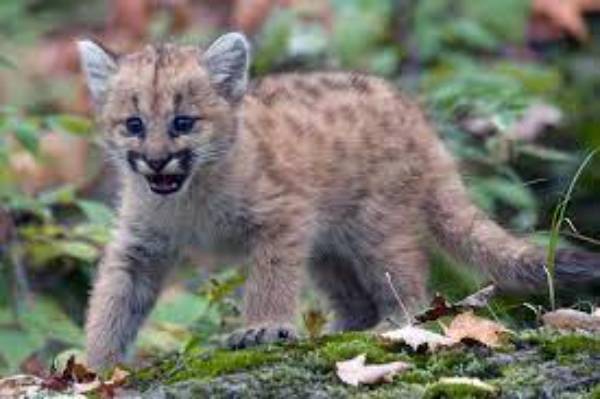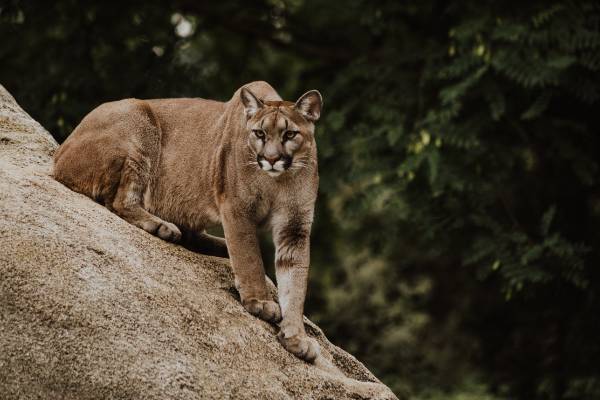Basic Information About The Young Mountain Lion

Many parts of North and South America are home to mountain lions, which are also known as mountain lions, pumas, and panthers. After a gestation period of about three months, mountain lion cubs are born. Cubs weigh about 400 grams (about one pound) at birth and have their eyes closed. We will talk about the young mountain lion from appearance, development, diet, eye, etc.
What Is The Mountain Lion
A large cat species native to the Americas is the mountain lion, also referred to as the mountain lion, puma, panther, or catamount. Large, tan cats, mountain lions are. Except for the whitish-gray belly and chest, their bodies are mostly covered in tawny-beige fur.
The tail tip, ears, and area around the snout are all decorated with black markings. The average body size of mountain lions varies greatly depending on where they live; they are smaller near the equator and larger near the poles.
However, in general, men weigh between 115 and 220 pounds (52 and 100 kilograms) and women between 64 and 141 pounds (29 and 64 kilograms).
What They Look Like
As meat-eating animals, mountain lions are carnivores. They are very adept at concealment and hardly ever come across in the wild.
Being mammals, mountain lions’ young consume their mothers’ milk. Its large size, cat-like appearance, uniformly gray to reddish-tan body color, and long tail—which is nearly three feet (1 m) long and accounts for a third of its overall length—help identify it.
The face, ears, and tail tip are blackly marked, and the muzzle and chest are white. Up until about six months of age, mountain lion kittens have black spots.
Adult females can weigh up to 120 pounds, while adult males can weigh up to 200 pounds (roughly the weight of an adult man).
Where They Live
Mountain lions are the most common land mammal in the Western Hemisphere, aside from people. From Patagonia, South America, to the northwest of Canada, mountain lions can be found. To find out where mountain lions reside in California and Washington, click on a range map.
Mountain lions build their dens in rocky ledges, thickets, and beneath uprooted trees. They are extremely territorial; a male mountain lion might have a home range of 50 to 150 square miles (the City of Seattle is 92 square miles, for reference).

Reproduce
Mountain lions are solitary animals that are only occasionally seen in pairs during the breeding season. The mountain lions’ breeding season is not set in stone. Any time of the year is a possibility. Between one and two years old is when a female reaches sexual maturity.
After two to three years of age, the males are ready to mate. These wild animals tolerate one another for the purpose of mating even though the two mates won’t be particularly friendly or affectionate with one another.
The mountain lions’ gestation period lasts almost three months. They locate a suitable den and give birth to their kittens only in this den in order to deliver a young mountain lion cat.
Cub Mortality
A wide range of potential predators, including fellow carnivores like bears, gray wolves, jaguars, and coyotes, as well as birds of prey like golden eagles, pose a threat to mountain lion cubs throughout their range.
However, research indicates that in many areas, adult male mountain lions pose the biggest threat to young mountain lions.
Although their ability to claw their way up trees provides them with some measure of protection at that point, cubs are likely most vulnerable once they have left their birthing lairs and are out and about with their mother.
Appearance And Development
At birth, mountain lion cubs weigh around 500 grams, or about pipsqueak size.
Heavy spotting covers these tiny cubs at birth: a coat pattern that’s lost with maturity, as adult mountain lions are basically uniformly tawny in color.
Other cats, like African and Asian lions, which, like the mountain lion, are solid-colored at maturity, have young that have more pronounced coat markings as well.
The cubs can better conceal themselves among the foliage thanks to that spotting. When mountain lion cubs first open their eyes, which happens within the first few weeks, they are blue; after a few months, the color of their eyes changes to that of adult mountain lions, which have brownish or grayish eyes.
They develop the hunting prowess that will serve them well as fully grown pumas by engaging in wrestling matches and other games with their littermates.
Coloring
Red, tawny gray, or brown describe the color of adult mountain lions. The cub’s fur, on the other hand, is brown at birth with black spots on the body and bars on the tail.
The spots start to disappear when the cub is 2 months old, and the cub starts to develop into its adult coloring. The spots are hard to see by six months, and by two and a half years after birth, every spot has disappeared completely.
Eyes
The eyes of newborn cubs are closed. Between 5 and 19 days after birth, the eyes open, and because of a lack of pigmentation, they appear blue. The cub’s eyes turn brown at around 5 months of age and stay that color for the rest of its life.
Care
In dens, females deliver the litter. In order to shield cubs from predators, dens can be found in rock crevices, holes, overhangs, and even low vegetation. However, they hardly ever contain bedding. Throughout their first 18 to 24 months of life, the cubs remain with their mother. Before the cub leaves to find its own territory, the mother teaches it how to hunt and survive.
Diet
For the first seven weeks of life, a newborn cub only eats its mother’s milk, just like all other mammals. The mother starts taking the cubs to kill as they get older and between 7 and 9 weeks old so they can eat the meat. At around 4 to 6 months old, kittens are completely weaned. Deer and other small animals are what mountain lions typically eat.
Habitat
Generally speaking, sagebrush-covered open areas and dense forests make up a mountain lion’s habitat. Mountain lion territories can range in size from 25 to 100 square miles. A mountain lion, also known as a mountain lion, typically prefers to live in regions with large populations of animals like deer, elk, and moose.
Populations of mountain lions are known to be very adaptable. These animals can easily survive in grasslands, coniferous mountain forests, tropical forests, swamps, grasslands, and desert scrub. The presence of prey animals is their only significant requirement from the environment.



